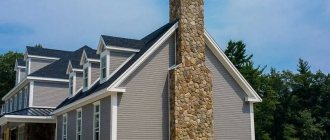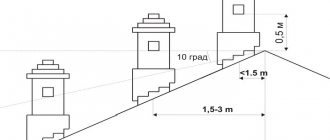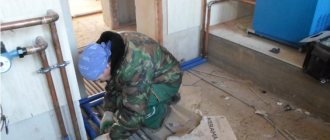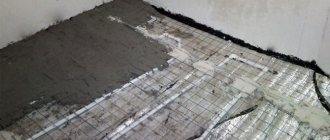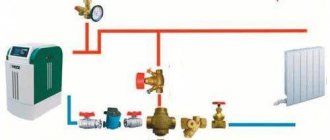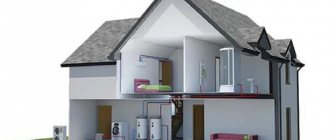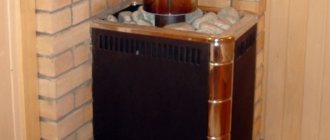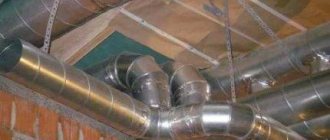The main function that a boiler room chimney should perform is to remove flue gases from boilers into the atmosphere and disperse them in this space. It also has an additional function: they must create natural draft resulting from the difference between the temperature in the firebox and outside.
We will introduce you to the types of smoke channels, the classification of which is based on the design features and material of the pipes. Here you will learn how to calculate geometric parameters using a specific example. Our advice will help you decide on the type and size of the chimney.
Materials for the construction of boiler pipes
Smoke exhaust systems are built from different materials - brick, steel, ceramics, polymer. A brick chimney, built over brick stoves and fireplaces, is characterized by good mechanical strength, excellent heat capacity, and a fairly high degree of fire safety.
These structures also have many disadvantages, which is why in modern construction completely brick chimneys are becoming less and less common. Regulatory documents limit the height of brick pipes to 30-70 m and the diameter to 0.6-8 m.
On the walls of a brick pipe with many protrusions and depressions inside, a lot of condensate and soot containing sulfur oxides always settle. The latter, reacting with water, forms acids that actively destroy bricks.
Surface unevenness and narrowing of the passage as a result of a gradual increase in the soot layer cause a decrease in the speed of smoke passage and overturning of the draft in the smoke exhaust channel.
Ceramic chimneys are more resistant to condensation and external factors; they have high fire resistance. But this system has a lot of weight, because Inside there are metal rods that give it additional strength. This entails the requirement for the mandatory installation of a separate foundation and supports, which increases the complexity and cost of installation.
Polymer chimney pipes are appropriate in boiler rooms with a maximum temperature of 250 degrees C, when installing geysers. They are lightweight, flexible and durable, but are only relevant for gas equipment.
A device for removing smoke from stainless steel is an assembly consisting of individual chimney elements connected to each other using shaped parts: tees, pipes, deflectors, tees, bends. Gas boilers are mainly equipped with steel chimneys.
Installation of such a chimney can be carried out after the construction of the building in a short time. There is a wide range of connecting parts, so the pipe can be given any configuration.
A modular chimney can be easily dismantled and moved to another location. The advantage of the design is its low weight, which allows you to do without a foundation, resistance to moisture, slight deposition of soot on the internal walls, and high speed of passage of flue gases.
Sanitary standards allow the use of steel pipes for the construction of chimneys with a height of more than 30 m; an exception is possible only if less than 5 tons of polyash fuel are consumed per day. The reason is that the service life of such structures is 10 years, and if high-sulfur fuel is used, it is significantly reduced.
Varieties whose body is made of steel alloy include coaxial chimneys, the design specifics and operating features of which we recommend that you familiarize yourself with.
Calculation methods
Exact method + formula
Calculating a chimney for a stove is not a task for beginners. It is better to entrust such work to professionals. But if you decide to calculate this parameter yourself, you will need knowledge of basic data and several formulas:
- To determine the volume of exhaust gases, it is important to know the power of the heating unit. For calculations we use the formula:, where:
- B is the combustion rate coefficient of solid fuel. This value is determined based on the data in table No. 10 of GOST 2127;
- V – level of volume of fuel burned. This value is indicated on the tag of the industrial device;
- T – heating level of exhaust gases at the exit point from the chimney. For wood stoves - 1500.
- The total area of the chimney. It is calculated based on the ratio of gas volumes, this value is designated “Vr”, and the speed of their movement in the pipeline. For a household wood-burning stove, this number is 2 m/sec.
- The diameter of a round pipe is calculated using the formula - d² = (4 * Vr) / (π * W), where W is the speed of gas movement. It is better to perform all calculations on a calculator and carefully enter all values.
Calculation of pipe parameters
To determine the height and diameter of the chimney for the boiler room, it is necessary to perform an aerodynamic design calculation. The diameter depends on the power of individual boilers or the entire boiler room.
The combustion of fuel and the effective removal of smoke are greatly influenced by draft, the creation of which requires a constant supply of air to the firebox. This is achieved both naturally and artificially.
If a smoke pump is built into the system, then the height of the pipe is not critical. This parameter is important mainly for accounting for harmful emissions into the atmosphere. To determine gravity, a mandatory calculation of both the height and cross-section of the pipe is required.
Determining the height of the pipe with natural draft
To create normal natural draft, it is necessary to comply with the condition of equality of the draft force and the total resistance that occurs during the movement of flue gases through the gas channels of the boiler and the chimney tract. It is possible to provide such traction provided there is little gas resistance, when the height of the pipe does not exceed 60 m.
This diagram will simplify the process of calculating the main parameters of a pipe for removing combustion products of any fuel in boiler room furnaces
Regulatory documents regulating the location and calculation of chimney heights are SNiP41-01-2003, SP 7.13130.2009.
You should also take into account the recommendations set out in the instructions for the boiler, in particular their following requirements:
- The distance from the grate to the top of the pipe should not be less than 5 m.
- Above a flat roof without a high fence, the pipe should rise at least 0.5 m.
- In relation to the height of the fence and roof ridge, the pipe should exceed their level by 0.5 m if it is within one and a half meters of these structures.
- When the chimney is removed from the parapet and ridge at a distance of 1.5 to 3 m, its top point should coincide with their level in height.
If the chimney height is incorrectly calculated, many problems can arise, the main one being air turbulence or a wind pressure zone. The fire in the furnace can be extinguished by strong gusts of wind.
When installing a chimney, it is necessary to take into account the roof structure, the thickness of the roofing pie, the distance to the enclosing elements and the ridge, fire safety rules (+)
Compliance with fire safety rules is also a prerequisite when designing a boiler room pipe. It is necessary to insulate structures adjacent to the pipe.
To prevent sparks from the ventilation holes on the pipe from falling onto the roof when it is made of flammable material, the height of the structure is increased by 0.5 m. The boiler room pipe must be at least 2 m away from tall buildings and trees.
The height of the pipe is determined depending on the roof structure. If the roof is multi-level, height differences are taken into account in the calculation, but the base is the same in all cases - the height of the ridge (+)
Since optimal draft occurs due to the difference between the total density of gases escaping into the chimney and a column of air outside equal in height, the calculation is performed using the formula:
The height of the smoke channel is independently calculated using this formula. All values can be taken from the documentation supplied with the heating equipment
The calculation is quite complicated, it is better if it is performed by specialists. Parameters affecting the height of the pipe:
- Coefficient A characterizes the meteorological situation in the region.
- Mi is the mass of flue gases that pass through the pipe per unit time.
- F is the speed at which particles formed during combustion settle.
- Spdki and Cfi are indicators of the concentration of various substances in the flue gas.
- V – volume of gas.
- T is the difference between the temperatures of the air entering and exiting the pipe.
If the boiler room is located in an extension to the house, the latter becomes a hindrance. In this case, it is necessary that the pipe head be located above the wind support zone. Otherwise, the heating equipment will not be able to function normally.
To determine how much the pipe needs to be increased, find the highest point on the house and draw a straight line through it, forming an angle of 45 degrees with the surface of the earth. The space below this line is the wind support zone, and the chimney should be located above it.
Calculation of pipe diameter
To calculate the diameter of the pipe there is a formula:
S = m/(ρr x w),
Here m is the fuel consumption for 1 hour, w is the speed of flue gases, ρr is the air density under operating conditions, it is determined by the formula: pв = pBну x 273⁄273 x tос. Where to is the outside air temperature, pBnu is the air density under normal conditions = 1.2932 kg/m3.
The table will help determine the value of air density ρg under operating conditions without performing complex calculations. To simplify calculations, the flue gas density is assumed to be equal to the air density (+)
Let 50 kg of solid fuel burn in the boiler per hour, then per second it will be 50: 3600 = 0.013888 kg. The speed of movement of flue gases is 2 m per second. At an air temperature of -4 degrees C, the air density is 0.6881 kg per 1 cubic meter. m. Then S = 0.013888: (0.6881 x 2) = 0.010092 sq. m = 92 sq. cm. For a circular section d = √4 x 92: 3.14 = 10.83 cm.
The diameter of a cylindrical chimney can be calculated using another formula: d = 1000/1.163 x (rx Q√H), where r is a coefficient depending on the type of fuel used. For coal it is 0.03, for firewood 0.045, for gas 0.016, liquid fuel - 0.024.
How to calculate chimney parameters?
As described above, you need to know certain parameters. If the two main parameters are height and cross-section, then there is one more indicator that must be taken into account. These are the characteristics of the heating equipment itself.
There are several forms of calculation, divided into:
By the first, we need to understand that it is necessary to take into account a lot of factors, including gas temperature indicators, separation speed, height and speed at which combustion of a particular fuel will occur. These values must be substituted into a special formula; a detailed calculation will be given at the end of the article.
As for the approximate calculation, the size of the combustion chamber is taken into account. For example, let’s take the classic size of a regular chamber in a furnace or boiler - these are dimensions within the range of 500 by 400 mm. The substitution system is used, that is, 1:10. Then for round channels, the diameter will be 180 - 190 mm.
The third type of calculation is the use of special calculation calculators. As a rule, they provide more accurate data, but you need to know more initial parameters. Roughly speaking, this is the same first method of counting, but it is performed using a computer.
Determining the height of the chimney
We already know that the performance of the system depends on this parameter. Therefore, keep in mind that according to SNiPs, the average height should be 5 meters, but not more than 7 meters. With a shorter length, natural traction will not be formed in sufficient quantities. When calculating, follow the described rules:
- From the base to the highest point is more than 5 meters.
- Exit to a flat roof is marked by an elevation of the pipe head by 500 mm.
- When erected on a pitched roof, three meters to the ridge, the chimney, when drawing a visual line, should be located at a 10 degree angle. The shorter the distance to the ridge, the correspondingly greater the degree.
Perform chimney height calculations
When making a fireplace or stove, much attention is paid to the chimney duct, since how efficiently the entire system will function depends on this element. In this case, one of the main tasks is to calculate the height of the chimney and its cross-section. These parameters determine the conditions for optimal traction depending on the type of heating device and other parameters. Today we will talk about how such calculations are performed. At the same time, we do not encourage you to do them yourself, since without practice, no theory can guarantee a high-quality result - however, new knowledge will not harm anyone.

